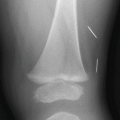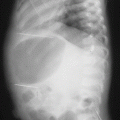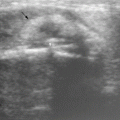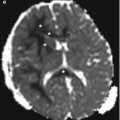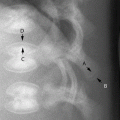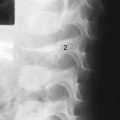and Marguerite M. Caré1
(1)
Department of Radiology ML5031, Cincinnati Children’s Hospital, Cincinnati, Ohio, USA
Keywords
RicketsLeukemiaChild abuseCopper deficiency4.1 Rickets and Other Metaphyseal Lucency
Many times infants who have rickets on radiographs have been considered mistakenly to be victims of child abuse. Therefore, I wish to emphasize the radiographic patterns of rickets (Fig. 4.1), so that they are not confused with child abuse.
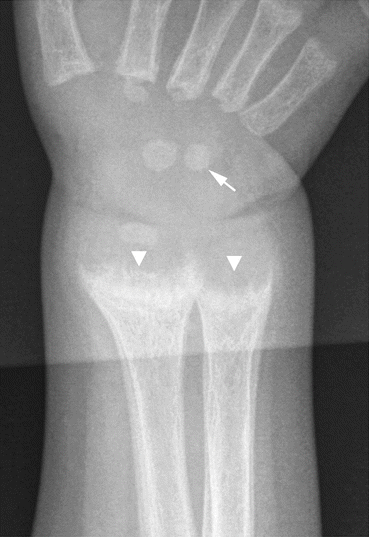

Fig. 4.1
Typical for rickets in this young child are the lack of calcified zone of provisional calcification (arrowheads) of the distal radius and ulna, as well as the similar lack of calcification of the zone of provisional calcification surrounding the two ossified carpal bones (arrow). In addition, the presence of secondary hyperparathyroidism (coarse traceculae, washed out cortices, and periosteal reaction from microfractures) is typically seen with rickets (Reprinted from Oestreich [19], with permission)
Rickets is a disease of growing bone. Therefore, if no growth is occurring (e.g., in severe hypothyroidism), no rickets will be evident. Rickets is a disease of enchondral bone growth, not of membranous bone growth. Therefore, physiologic periosteal reaction along long tubular bone shafts (observed usually between about 1 and 7 months of age) will still occur in rickets. Bone cortex and bone bark should be normally formed in rickets, except insofar as they may be affected by secondary hyperparathyroidism . Because of the lack of mineralization of cartilage in rickets at the expected level which otherwise would have been a zone of provisional calcification, several imaging consequences occur:
- 1.
Zones of provisional calcification will not be visible, neither at the physis nor at other sites of enchondral growth, including around secondary growth centers and around tarsal and carpal bones (Fig. 4.2).

Fig. 4.2
Thin section postmortem radiograph of a child with rickets similarly shows (as in Fig. 4.1) lack of zones of provisional calcification at the distal femoral metaphysis (arrowheads) and around the secondary growth center (arrow), together with secondary hyperparathyroidism (Reprinted from Fraenkel and Lorey [20])
- 2.
As a result of “1,” the distance between epiphyseal growth center ossification and metaphyseal ossification increases, making the unmineralized “physis” longitudinally wider than normal. Moreover, since the carpal bones and other epiphyses are surrounded by excessive unmineralized cartilage, the apparent bone age will be less than expected.
- 3.
Perhaps because of secondary hyperparathyroidism affecting bone bark, the metaphyses of long bones appear irregular or frayed.
- 4.
The anterior growing ends of ribs similarly do not show mineralized zone of provisional calcification. Moreover, those rib ends are transversely widened, yielding radiographic and clinical “rachitic rosary ” (Fig. 4.3). Clinically and radiologically transversely widened wrists also may be seen. Just perhaps, the reason for transverse widening of anterior ribs and metaphyses of long tubular bones relates to an impairment of the metaphyseal collar in constraining transverse growth. Interestingly, a similar scorbutic rosary can appear in scurvy , but then the zone of provisional calcification instead of being unseen is seen with greater conspicuity than normal.
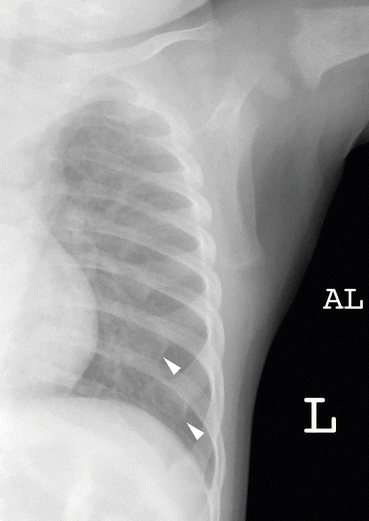
Fig. 4.3
Rachitic rosary in a 9-month-old. Arrowheads indicate some of the widened anterior ends of ossified ribs, lacking the zones of provisional calcification. The proximal humerus also shows changes of rickets
- 5.
Although the bone bark at its margins are still mineralized in the metaphyseal region, the expected metaphyseal new formed bone within the metaphyseal collar is unmineralized. Therefore, in rickets, a metaphyseal collar is no longer seen. That is a key early finding of rickets at, for example, the distal radius and ulna, the ankle, and the knee.
- 6.
A valuable sign of rickets is finding evidence of secondary hyperparathyroidism.
- (a)
Washing out of cortices (increased tunneling manifest as “holes” in cortex).
- (b)
Loss of lamina dura (Figs. 4.4, 4.5, and 4.6) around unerupted and erupted teeth (lamina dura being the equivalent of long bone cortices). Other reasons for loss of lamina dura include local infection, Langerhans cell histiocytosis, and lymphoma.
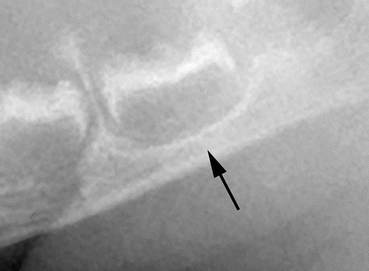
Fig. 4.4
The well defined white line in the mandible surrounding all but the erupted crown of this infant’s molar (arrow) is the normal lamina dura (an analogue of long bone cortex) which if not present may be a sign of hyperparathyroidism (or infection, Langerhans cell histiocytosis, or lymphoma)
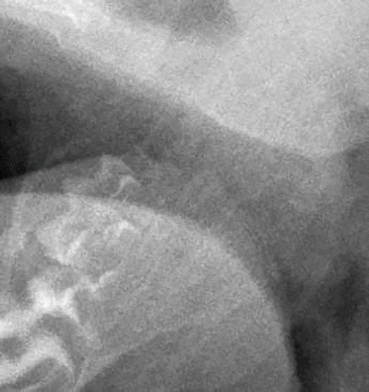
Fig. 4.5
The posterior mandibular teeth in this 9-month-old with secondary hyperparathyroidism totally lack the dense line of the lamina dura
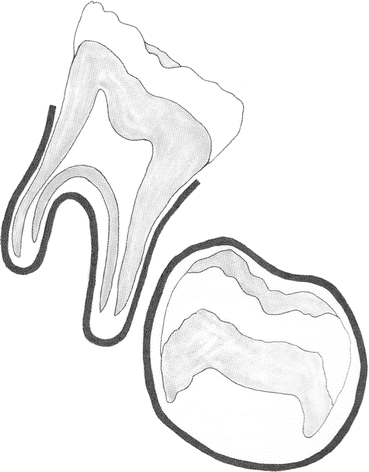
Fig. 4.6
Artist rendition (by Tamar Kahane Oestreich) of normal lamina dura around the base and midsection of an erupted tooth and surround the entire bud of a not yet erupted tooth (Reprinted from Oestreich [21])
- (c)
Coarser than normal trabeculae in bones (Figs. 4.7 and 4.8).

Fig. 4.7
Thin section postmortem radiograph of a clavicle of a child with marked hyperparathyroidism secondary to rickets. The trabeculae are conspicuously coarse and the cortex is severely washed out and ill defined. The lack of zone of provisional calcification at the physeal end of the clavicle indicates the causative rickets (Reprinted from Fraenkel and Lorey [20])
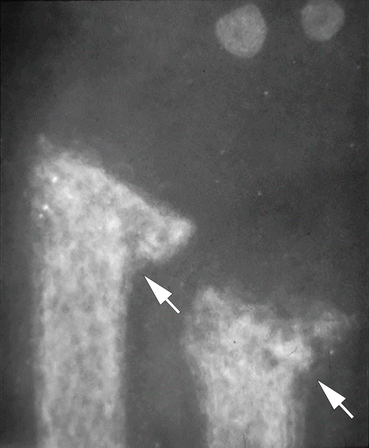
Fig. 4.8
Radiograph of a contemporary child with severe hyperparathyroidism, with dramatically coarse trabeculae, washed out cortex, and fractures through the weakened bone (arrows)
- (d)
Loss of continuity of the ossified margins of terminal tufts of phalanges.
- (e)
Fractures through hyperparathyroidism-affected tubular bones. These fractures need to be distinguished from abusive trauma fractures.
- (a)
When rickets heals, the zones of provisional calcification mineralizes first, prior to the filling in with mineralized bone in the metaphyseal collar region (Fig. 4.9). When rickets is successfully treated, rachitic changes reverse earlier than changes of secondary hyperparathyroidism. An unusual pattern occurs when rickets partially heals and then recurs, yielding an “Afghan turban” appearance [1].
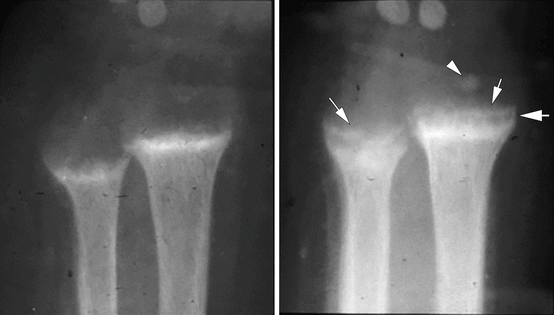

Fig. 4.9
To the viewer’s left is advanced nutritional rickets, without visible zone of provisional calcification and with poorly defined distal radius growth center. With less than 10 days after initiating dietary treatment, the zone of provisional calcification reappears first (narrower a arrows), leaving the still undermineralized adjacent metaphysis to fill in days later (thicker arrow). Note also that the radius secondary growth center (arrowhead) is now more clearly defined (Modified from Oestreich and Ahmad [22], with permission)
In my experience, the radiologist may be the first to suggest a diagnosis of rickets even when it is not suspected clinically [2].
Fractures are generally through hyperparathyroidism-affected bone rather than rickets affected sites. Long-term bowing of lower extremity bones is through hyperparathyroidism affected bone rather than rickets affected sites.
Rickets should not be falsely diagnosed in abuse trauma radiographs.
Paul Kleinman and his group have nicely demonstrated histologically (on postmortem studies) that longitudinal metaphyseal lucencies, representing unmineralized chondrocytes, may be a recognizable sequel of abusive trauma [3]. Rather than considering healing fractures, I would describe the tongues of lucency as unhealed damage to the cartilage cells. Nonetheless, be alert for such metaphyseal lucencies in the skeletal series looking for abuse. The appearance is reminiscent of hypophosphatasia , in which selected areas of the metaphysis similarly remain unmineralized (hypophosphatasia is related to mutations in tissue nonspecific alkaline phosphatase).
One should recognize the normal “bone-in-bone ” vertebral appearance between a few weeks and several months of age. The endplates and parts of the anterior margins of vertebral bodies are zones of provisional calcification, of normal density, while the postnatal bone between those zones and the normally dense prenatal bone are less dense. This appearance is not abnormal. It was bravely reported from a study of well babies some years ago [4] (see Fig. 2.16).
4.2 Osteoporosis/Scurvy
In osteoporosis in childhood, the key plain imaging feature is the greater conspicuity of the zones of provisional calcification (ZPC) (Fig. 4.10). The cartilaginous zones of provisional calcification are normally dense in contrast to the less dense than normal bone adjacent. Thus, the ZPC white (dense) line is more sharply seen. The more conspicuous ZPC around epiphyseal centers is precisely the Wimberger sign in scurvy (Fig. 4.11). In osteoporosis, the cortices of long bone do not show the increased unsharpness of hyperparathyroidism. Often, the decrease in physical activity accounts for a thinner cortex in such patients. The Trümmerfeld of scurvy represents metaphyseal injury which may resemble the classic metaphyseal lesions of abuse – thus when seeing apparent CMLs, look for other signs of scurvy (or copper deficiency , which gives similar findings). Slipped epiphyses, including at the distal femur, may occur in scurvy (Fig. 4.12). A scorbutic rosary (akin to but different from the rachitic rosary) also shows the conspicuous zone of provisional calcification (Fig. 4.13).
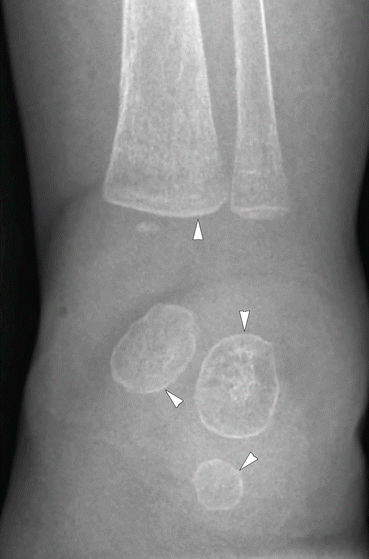
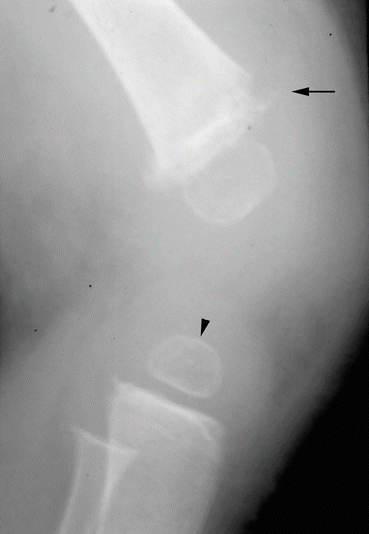

Fig. 4.10
In osteoporosis (as opposed to rickets) not only are the cartilaginous zones of provisional calcification present (arrowheads), but they become much more conspicuous than normal because of the adjacent demineralized osteoporotic bone

Fig. 4.11




In this young child with scurvy, an osteoporotic condition, the more conspicuous than normal cartilaginous zone of provisional calcification is precisely what is known in scurvy as the Wimberger sign (arrowhead), and the crumbling of metaphysis from weakened bone (arrow) is known as the Trümmerfeld zone
Stay updated, free articles. Join our Telegram channel

Full access? Get Clinical Tree



